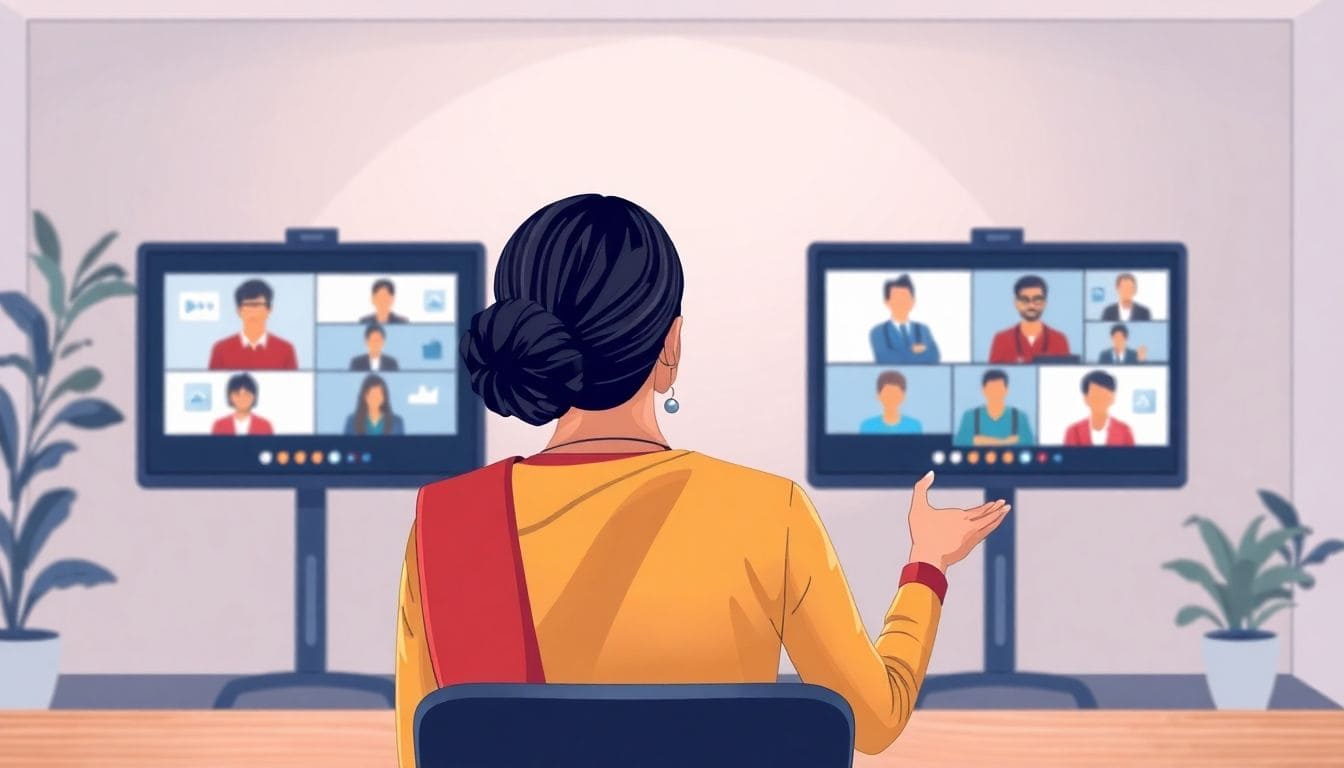When it comes to giving presentations, what you say is just one part of the equation. Your body language greatly influence show your message is received. It can either enhance your presence or distract from your point.
When you present as a part of your job, your body language can either secure your next promotion or, it could lead you toward a PIP (performance improvement plan).
Listening is not about hearing the person; it is about understanding the person. Your body language and other non-verbal communication cues can make it easier for the person to understand what you are trying to communicate.
This article will explore how to improve body language to boost your confidence and engage your audience effectively. You’ll learn practical tips for using gestures, maintaining good posture, and making eye contact, all of which can help you command the room and connect with your listeners.
Key Takeaways
- Body language is a key part of communication that can enhance or undermine your message.
- Good posture helps project confidence and authority during presentations.
- Effective eye contact fosters connection and engagement with your audience.
- Using gestures can emphasize key points and keep your audience engaged.
- Practicing your body language can help you appear more natural and confident when presenting.
Understanding The Power Of Body Language

The Impact Of Nonverbal Communication
Ever wonder why some speakers just grab your attention, even before they say a word? It’s body language, plain and simple. We’re talking about a whole silent language that speaks volumes. Think about it: a confident stance, a genuine smile, or even a slight hesitation can change how your message lands. Nonverbal cues can either amplify or completely undermine what you’re trying to say. It’s not just about the words; it’s about the vibe you’re putting out there.
Body language is like the background music of your presentation. If it’s off-key, it can ruin the whole performance, no matter how great the lyrics are.
How Body Language Influences Perception
People are quick to judge, and a lot of that judgment comes from what they see, not just what they hear. Your posture, gestures, and facial expressions all contribute to the story your audience is piecing together about you. Do you look confident and trustworthy, or nervous and unsure? These nonverbal signals shape their perception of your competence, credibility, and even your likeability. It’s a bit unfair, maybe, but it’s reality.
The Connection Between Body Language And Confidence
Here’s a cool thing: body language isn’t just about how others see you; it’s about how you see yourself. Adopting confident postures can actually boost your own feelings of confidence. It’s like a feedback loop. When you stand tall and make eye contact, you feel more in control, and that confidence shines through to your audience. It’s a simple trick, but it can make a huge difference. Your body language can change your mindset.
Mastering Posture For Maximum Impact
The Importance Of Standing Tall
Think of your posture as the foundation of your presence. It’s not just about looking good; it’s about projecting confidence and authority. Standing tall instantly commands attention and signals that you’re someone to be taken seriously. It’s a simple adjustment that can make a world of difference. Good posture also increases our sense of “being energized”.
How Posture Affects Your Message
Your posture isn’t just about how you look; it directly impacts how your message is received. Slouching can make you appear unsure or even uninterested, while a strong, upright posture conveys conviction and passion. It’s about aligning your physical presence with the message you’re trying to convey. Think of it as non-verbal punctuation – it adds emphasis and clarity. Train yourself to stand upright often outside of presentations, as posture habits inform body language cues.
Techniques For Improving Your Posture
Improving your posture isn’t about overnight transformations; it’s about consistent effort and awareness. Start by consciously correcting your posture throughout the day. Set reminders to check in with yourself and make adjustments as needed. Incorporate exercises that strengthen your core and back muscles, as these are essential for maintaining good posture.
Practice “posture for confidence” regularly, especially prior to a speech or interview—think of it like stretching your confidence. Find a private place, and stretch yourself wide open: shoulders back, chest forward, tilt your head up, and place your fists on your hips. By the way, this is also called the “Wonder Woman” pose. Hold it for two minutes, focusing on feeling confident and comfortable as you do so.
Engaging Your Audience With Eye Contact

The Role Of Eye Contact In Communication
Eye contact in speaking is more than just a visual connection; it’s a powerful tool for building trust and rapport. Think about it: when someone avoids your gaze, you might wonder what they’re hiding. Good eye contact signals confidence and sincerity, making your message more believable and impactful. It’s about creating a human connection, showing your audience that you’re genuinely engaged with them.
How To Maintain Eye Contact Effectively
Maintaining effective eye contact isn’t about staring intensely at one person. Instead, try scanning the room, making brief, meaningful connections with individuals. Hold eye contact for a few seconds before moving on, giving each person a moment of your attention. If you find direct eye contact intimidating, focus on the bridge of their nose – it creates a similar effect without the intensity. Remember, it’s about making people feel seen and heard.
Reading Audience Reactions Through Eye Contact
Eye contact isn’t just about transmitting information; it’s also about receiving it. Pay attention to your audience’s eyes – are they engaged, confused, or bored? Their gaze can provide valuable feedback, allowing you to adjust your delivery and keep them hooked. If you notice glazed-over eyes, it might be time to inject some energy or clarify your points. It’s a two-way street, and their eyes are telling you a story.
Effective eye contact is a learned skill that takes practice. Start with friends and family, asking them to point out when your gaze drifts. With time and effort, you’ll become a master of connection, captivating your audience with the power of your eyes.
Using Gestures To Enhance Your Message

Types Of Effective Hand Gestures
Alright, let’s talk gestures. Not just any gestures, but the kind that actually make your message stick. Think about it: are you using your hands to paint a picture, or are they just flapping around like you’re trying to take flight? Effective gestures are intentional and add to what you’re saying. Open palms can signal honesty, while pointing can direct attention. It’s about finding what works for you and your style.
Avoiding Distracting Movements
Okay, real talk: fidgeting is a presentation killer. We’re talking about the pen clicking, the hair twirling, the constant shifting from foot to foot. These hand movements in presentations don’t just distract your audience; they scream nervousness and undermine your message. The goal is to be aware of these habits and actively work to eliminate them. Sometimes, less is more.
Imagine you’re watching someone speak, and they keep touching their face. It’s hard to focus on what they’re saying, right? That’s what distracting movements do. They pull focus from your message and put it on your anxiety.
I like to think about it as visual clutter.
Practicing Gestures For Natural Delivery
Here’s the secret sauce: practice, practice, practice. You can’t just wing it and expect your gestures to look natural. It takes time and effort to integrate them seamlessly into your delivery. Stand in front of a mirror, record yourself, and get feedback from trusted friends or colleagues. The goal is to make your gestures feel like a natural extension of your words, not a forced performance. communication skills are key to success. It’s about using gestures effectively to amplify your message, not overshadow it. With enough practice, you’ll be gestures for impactful communication in no time.
Facial Expressions: The Unspoken Words
Facial expressions? They’re not just there to make you look pretty. They’re a powerhouse of communication, often saying more than your words ever could. Think about it: a genuine smile can disarm a room, while a furrowed brow can signal concern or confusion. It’s all about using your face as the expressive tool it is.
How Facial Expressions Convey Emotion
Your face is like a billboard for your feelings. It’s broadcasting whether you’re happy, sad, angry, or confused. The key is to make sure your face is telling the same story as your words. If you’re talking about a success, let your face light up with a smile. If you’re discussing a challenge, show some concern. It’s about being authentic and letting your emotions shine through.
Ever notice how some people seem to have a permanent expression? It might be a ‘resting face’ or a default frown. Being aware of your typical expression is the first step to making sure it aligns with what you’re actually feeling and saying.
Aligning Expressions With Your Message
It’s not enough to just feel the emotion; you’ve got to show it. This means practicing matching your facial expressions to your message. If you’re talking about something exciting, let your eyes widen and your smile broaden. If you’re discussing something serious, let your brow furrow and your expression become more somber. It’s about being intentional and using your face to amplify your words. Think of it as adding emotional punctuation to your sentences. For example, effective presentation skills can be enhanced by aligning facial expressions with the message.
Practicing Expressive Communication
Okay, so how do you actually get better at this? Practice, practice, practice! Stand in front of a mirror and make different faces. Exaggerate your expressions. See how it feels to really show what you’re feeling. It might feel silly at first, but it’s a great way to become more aware of your facial muscles and how to control them. Record yourself giving a presentation and watch it back with the sound off. What does your face say? Does it match your message? If not, keep practicing until it does.
Movement: Commanding The Space
Movement on stage isn’t just about avoiding looking like a statue; it’s about effective use of space on stage to amplify your message and connect with your audience. Think of it as choreography, not chaos. Let’s break down how to make every step count.
The Benefits Of Purposeful Movement
Why move at all? Because a static speaker is a boring speaker. Purposeful movement keeps your audience engaged, emphasizes key points, and helps you connect with different sections of the room. It shows confidence and control, not nervousness. It’s about owning the space, not just occupying it.
How To Use Space To Engage
Don’t just wander aimlessly. Plan your movements. Use different areas of the stage to represent different ideas or sections of your presentation. Step forward when making a crucial point to create emphasis. Move to the side to transition to a new topic. Think of the stage as a canvas and your movements as brushstrokes.
Avoiding Nervous Habits While Moving
Fidgeting, pacing, swaying – these are all movement killers. They distract your audience and undermine your credibility. Be aware of these habits and actively work to eliminate them. Plant your feet when making key points. Pause before moving to gather your thoughts. capture attention Remember, stillness can be just as powerful as movement.
Aim to stand still for the majority of your talk. This will convey confidence and authority. Plan in advance when you will move, combing those movements with breaks in your content. Express a full thought or point in your new position before moving again.
Adapting Body Language For Different Audiences
Understanding Cultural Differences
Body language isn’t universal; what’s acceptable in one culture might be offensive in another. For example, direct eye contact is valued in many Western cultures as a sign of honesty and engagement. However, in some Asian cultures, prolonged eye contact can be seen as disrespectful or challenging.
Being aware of these differences is the first step in adapting your body language effectively. Do some research before presenting to a diverse audience. It can save you from awkward situations or, worse, damaging your credibility.
Tailoring Your Approach For Engagement
The key is to be adaptable and observant. What works for a room full of seasoned executives might not resonate with a group of college students. Consider the audience’s background, their level of familiarity with the topic, and their expectations. A more formal setting might require a more reserved demeanor, while a casual environment allows for more expressive gestures and movement.
Adjusting Your Style Based on Audience Size
Your body language needs to scale with the size of the audience. In a small group, subtle nods and attentive listening can create a strong connection. But in a large auditorium, you’ll need to amplify your gestures and movements to ensure everyone can see and feel your engagement. Think bigger, bolder, and more deliberate.
Remember, reading audience body language is a continuous process. Pay attention to their reactions, adjust your approach as needed, and strive to create a connection that transcends cultural and contextual differences. It’s about being present, being aware, and being respectful.
Integrating Body Language Into Presentation Preparation
Planning Your Physical Presence
Think of your body language as a silent partner in your presentation. It’s not just about what you say, but how you say it. Before you even start crafting your slides, map out key moments where specific non-verbal cues in public speaking can amplify your message. Where can you stand tall to project confidence? Where can a well-timed gesture underscore a critical point? This isn’t about being robotic; it’s about being intentional.
Rehearsing With Intentional Movements
Rehearsal isn’t just about memorizing your speech; it’s about embodying it. Practice your movements, your gestures, and your facial expressions. Are they natural? Do they align with your words? Record yourself and watch it back. It might feel awkward, but it’s the best way to identify distracting habits or areas where your public speaking body language isn’t quite hitting the mark. Use mirroring techniques to see how others perceive you.
Feedback Loops For Continuous Improvement
Don’t be afraid to ask for feedback. Show your rehearsal recordings to trusted friends or colleagues and ask for honest opinions. Do you appear confident? Do your gestures seem natural? Are there any distracting mannerisms? Use this feedback to refine your effective speaking presence and continuously improve your body language techniques. Remember, even small adjustments can make a big difference in your overall impact.
Body language is a skill, and like any skill, it requires practice and refinement. Don’t expect to become a master overnight. Be patient with yourself, be open to feedback, and keep practicing. With time and effort, you can learn to use your body language to enhance your presence and impact in every presentation.
When preparing for a presentation, it’s important to think about how your body language can impact your message. Using gestures, facial expressions, and posture can help you connect better with your audience. Practice in front of a mirror or record yourself to see how you come across. Want to learn more tips on improving your presentations? Visit our website for helpful resources!
Next Steps: Let Your Body Speak for You
You now know body language isn’t a side note—it’s a key driver of your professional impact. Transforming your nonverbal communication can dramatically boost your presence, elevate your message, and enhance audience engagement. Choose one area from this article—whether posture, gestures, eye contact, or movement—and commit to practicing it intentionally this week. Set calendar reminders every Monday for the next 4-6 weeks to revisit and reinforce these skills, making incremental improvements each time. But the next step is entirely up to you.
- You can keep reading tips and hoping things get better naturally, but hope isn’t a strategy. Real confidence comes from taking intentional action. What are you going to change or do differently after reading this? The choice is yours.
- Struggling with anxiety before speaking? You’re not alone. Cooper Camak’s free Overcome Speaking Anxiety Masterclass uncovers the root causes of nerves and provides actionable techniques to speak calmly under pressure.
- Want a structured plan to enhance your confidence quickly? Cooper Camak’s 21 Days to More Confidence & Credibility course delivers proven methods to communicate with clarity, command attention, and accelerate your career growth.
Choose your next move wisely—your audience, your career, and your confidence depend on it.
Frequently Asked Questions
What is the importance of body language in presentations?
Body language is crucial because it helps convey your confidence and connects you with your audience. It can make your message more engaging and memorable.
How can I improve my posture while presenting?
To improve your posture, stand tall with your shoulders back and keep your feet grounded. Practice good posture regularly, even when sitting.
Why is eye contact important during presentations?
Eye contact helps you connect with your audience and shows that you are engaged and sincere. It makes your message feel more personal.
What types of gestures should I use in my presentation?
Use natural hand gestures that emphasize your points. Avoid distracting movements, and make sure your gestures match your words.
How can I control my facial expressions while speaking?
Practice in front of a mirror to become aware of your facial expressions. Try to match your expressions with the emotions of your message.
How can I adapt my body language for different audiences?
Research your audience’s culture and preferences. Adjust your gestures and expressions to fit their expectations and comfort levels.









